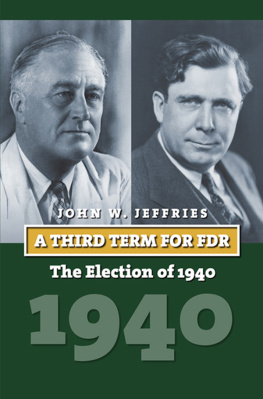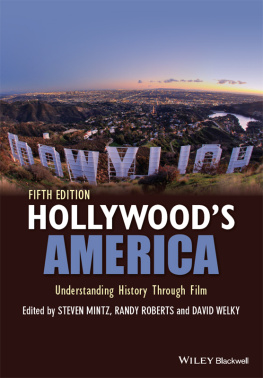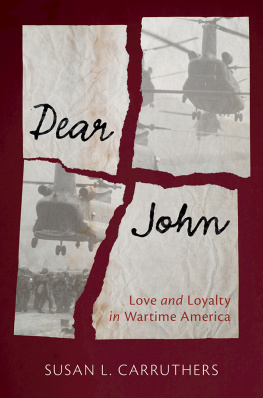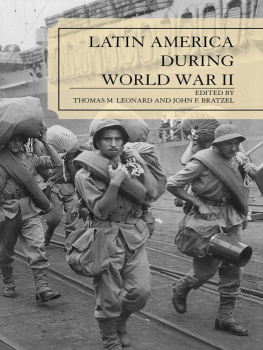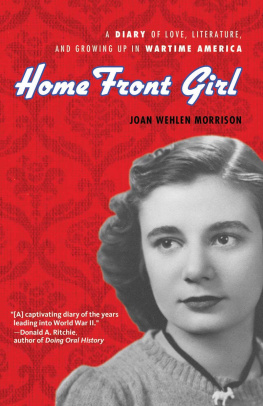A Note on Sources
Although primarily a work of synthesis, this book also draws on my own research on the World War II home front and wartime politics and policy-making. In that work I have consulted especially records in the Franklin D. Roosevelt Library, the National Archives, the Harry S. Truman Library, the Lilly Library at Indiana University, and the Roper Public Opinion Research Center; a variety of government publications; and a range of contemporary newspapers, magazines, and journals of opinion.
But Wartime America rests principally upon studies by other scholars. What follows is a brief listing of those I found most useful, in both writing and revising the book. Numerical data were obtained from The Statistical History of the United States from Colonial Times to the Present (Stamford, CT: Fairfield Publishers, 1965) as well as from other sources listed; it should be noted that data on wartime America and on other home fronts often vary, sometimes considerably, from source to source.
World War II was termed a many-sided social revolution by Eliot Jane-way in The Struggle for Survival: A Chronicle of Economic Mobilization in World War II (New Haven, CT: Princeton University Press, 1951), but the notion of a watershed began to inform modern historiography in the 1970s, especially after William H. Chafes account of the impact of the war on women in The American Woman: Her Changing Social, Economic, and Political Roles, 19201970 (New York: Oxford University Press, 1972), and Richard M. Dalfiumes Desegregation of the U.S. Armed Forces: Fighting on Two Fronts, 1939 1953 (Columbia: University of Missouri Press, 1969). In his excellent War and Society: The United States, 19411945 (Philadelphia: Lippincott, 1972), Richard Polenberg maintained that Pearl Harbor signified the end of an old era and the beginning of a new. Geoffrey Perrett, Days of Sadness, Years ofTriumph: The American People, 19391945 (New York: Coward, McCann & Geoghegan, 1973) called the war years the closest thing to a real social revolution the United States has known in this century. Allan M. Winklers Home Front U.S.A.: America During World War II 3rd ed. (Hoboken, NJ: Wiley-Blackwell, 2012), probes the watershed thesis and comes down more on the side of change than of continuity. John Morton Blum, V Was for Victory: Politics and American Culture During World War II (New York: Harcourt Brace Jovanavich, 1976) is an illuminating study of wartime America emphasizing inertia and continuities. The Washington Post special section on World War II was published July 26, 1995.
Kenneth Paul OBrien and Lynn Hudson Parsons, eds., The Home-Front War: World War II and American Society (Westport, CT: Greenwood Publishing Group, 1995) contains both a useful collection of essays and a detailed guide to then-recent studies of the home front. John W. Jeffries, William M. Tuttle, Jr., Nelson Lichtenstein, and Harvard Sitkoff, World War II and the American Home Front (Chicago: Ivan R. Dee, 2007) contains useful essays and bibliographical references. Cynthia Rose, Project Editor, American Decades: Primary Sources, 19401949 (Farmington Hills, MI: Gale Cengage Learning, 2004), includes short essays and many primary sources bearing on the war years. David M. Kennedy, Freedom from Fear: The American People in Depression and War, 19291945 (New York: Oxford University Press, 1999), is the essential starting point for the era.
A growing number of regional, state, and local studies have assessed the impact of World War II on American life. Those that emphasize change include Gerald D. Nash, The American West Transformed: The Impact of the Second World War (Bloomington: Indiana University Press, 1985); Marilynn Johnson, The Second Gold Rush: Oakland and the East Bay in World War II (Berkeley: University of California, 1993); Neil R. McMillen, ed., Remaking Dixie: The Impact of World War II on the American South (Jackson: University of Mississippi, 1997); Morton Sosna, More Important Than the Civil War? The Impact of World War II on the South, in Perspectives on the American South: An Annual Review of Society, Politics, and Culture, vol. 4, ed. James C. Cobb and Charles R. Wilson (New York: Taylor & Francis, 1987), 14561; Pete Daniel, Going Among Strangers: Southern Reactions to World War II, in Journal of American History, 77 (December 1990), 886911; C. Calvin Smith, War and Wartime Changes: The Transformation of Arkansas, 1940 1945 (Fayetteville: University of Arkansas Press, 1986); and Richard E. Holl, Committed to Victory: The Kentucky Home Front during World War II (Lexington: University of Kentucky, 2015). Studies that in varying degrees find important continuities as well as change include: R. Douglas Hurt, The Great Plains during World War II (Lincoln: University of Nebraska Press, 2008); Alan Clive, State of War: Michigan in World War II (Ann Arbor: University of Michigan, 1979); John W. Jeffries, Testing the Roosevelt Coalition: Connecticut Society and Politics in the Era of World War II (Knoxville: University of Tennessee, 1979); Marc Scott Miller, The Irony of Victory: World War II and Lowell, Massachusetts (Urbana: University of Illinois Press, 1988); and articles in the special issue of the Pacific Historical Review, 63 (August 1994), devoted to Fortress California at War.
Paul Fussells Wartime: Understanding and Behavior in the Second World War (New York: Oxford University Press, 1989) takes sharp issue with the notion of a Good War, as does Richard Polenbergs The Good War? A Reappraisal of How World War II Affected American Society, Virginia Magazine of History and Biography, 100 (July 1992), 295322. Michael C. C. Adams, in The Best War Ever: America and World War II (Baltimore: Johns Hopkins University Press, 1994), shows both sides of the war but seeks especially to counter popular notions of the Good War, while William L. ONeill in A Democracy at War: Americas Fight at Home and Abroad in World War II (New York: Free Press, 1993) finds much to criticize but also much to celebrate. John Bodnar, The Good War in American Memory (Baltimore: Johns Hopkins University Press, 2010) is an illuminating account of how World War II has been understood, remembered, and memorialized. Kenneth D. Rose, Myth and the Greatest Generation: A Social History of Americans in World War II (New York: Routledge, 2012) takes exception both to the idea of the Greatest Generation, popularized in Tom Brokaws book, The Greatest Generation (New York: Penguin Random House, 1998) and to the related understanding of the Good War. Lewis A. Erenberg and Susan E. Hirsch, eds., The War in American Culture: Society and Consciousness During World War II (Chicago: University of Chicago Press, 1996), contains important essays that while challenging the idea of the Good War see the war years as a major turning point, and ultimately in generally positive ways, for American society and culture. Neil A. Wynn The Good War: The Second World War and Postwar American Society, Journal of Contemporary History, 31 (July 1996), 46382, examines the impact of the war in a way that demonstrates how the Good War and watershed analyses are related. For coverage of the contentious and heated panel discussion at the 1989 annual meeting of the Organization of American Historians, see A Round Table: The Living and Reliving of World War II, in the Journal of American History, 77 (September 1990), 553593. For papers developed from of a panel at the 2013 American Studies Association Annual Meeting, see Birgit Dwes and Ingrid Gessner, eds., Commemorating World War II at 70: Ethnic and Transnational Perspectives,


